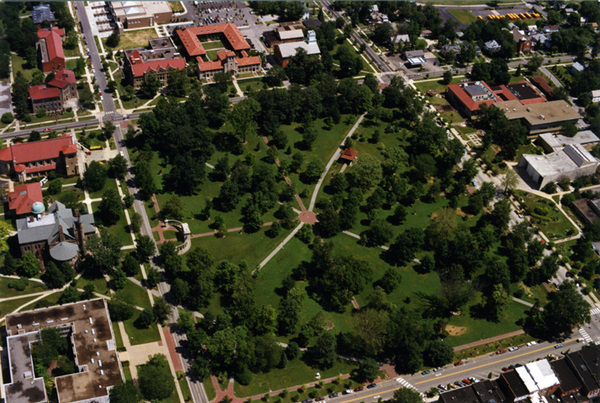Tappan Square
Date
Settlement: 1833Location
Bounded by N. Main Street, W. Lorain Street, N. Professor Street, and W. College StreetArchitects/Collaborators
1914 walkways and tree planting: Olmsted Brothers (1898-1980), Brookline, MA (landscape architects)Plantings: Beatrix Jones Farrand (1872-1959) (landscape architect)
History
Tappan Square, Oberlin’s picturesque town green comprising 13 acres, was first cleared of trees in order to create space to build a college. Early settlers began removing trees between 1833 and 1836, adding a worm fence and later one of Osage Orange to keep out roaming cattle. It was briefly known as “stumpville” due to the large number of tree stumps left behind during the clearing, and later was known as the “Campus” or “College Park.” It wasn’t until after World War II that the area became commonly known as Tappan Square. Several of the College’s first buildings once stood on Tappan Square, including Tappan Hall, the square’s namesake. Built in 1836, Tappan Hall was named after Arthur Tappan, a merchant abolitionist and an early donor to the college. The next addition to the square didn’t occur until 1855, when the College Chapel was built. In 1868 construction was completed on French Hall and Society Hall, both located on the western side of the square. Spear Library-Laboratory was constructed in 1885, the same year Tappan Hall was torn down. A Victorian bandstand providing a venue for musical entertainment stood on the square near the corner of North Main and West College Streets from 1879 to 1907, when it burned down. In the 19th century, three geologicaly significant boulders were moved to the square. Two of them were freed from Plum Creek by members of the classes of 1882 and 1898 respectively and formally presented to the College. Since 1962 these have been painted over by students for graffiti.In 1903 the Memorial Arch was built and the College Chapel was destroyed by fire. That year the Olmsted Brothers, sons of the great landscape architect Frederick Law Olmsted, produced a campus plan for the College that called for removing all the buildings from the square to create a green space. In 1914 the College retained the Olmsted Brothers as consultants again. At the firm’s recommendation, brick walkways were added to the square and trees were planted. It wasn’t until 1927 that the College could raze the buildings on the square as recommended, under the terms of the estate of Charles Martin Hall, the Oberlin graduate who discovered the process for refining aluminum metal. The College relocated and reconstructed the buildings’ functions elsewhere on campus. A plaque in Tappan Square commemorates Hall’s contribution, which ensures Tappan Square will remain a beautiful open space for the town and college to enjoy. The College conducted massive tree planting campaigns in the years since the square's initial deforestation, including under the 1914 plan by the Olmsted Brothers. But in the 1960s Dutch Elm Disease decimated most of the elms. This included, in 1965, the removal of the square’s Historic Elm, which had grown in the square since before 1833. Trees have been planted and cataloged continuously since then. The final structural addition to the square was the 1987 Clark Bandstand. The bandstand and the Memorial Arch remain the only two structures standing on the square, other than the Hall memorial ring and the Hall plaque.
Sources
Geoffrey Blodgett, Oberlin Architecture, College and Town: A Guide to Its Social History (Oberlin, OH: Oberlin College, 1985), 1-2.
Geoffrey Blodgett, Oberlin History: Essays and Impressions (Kent, OH: Kent State University Press, © 2006), 236-237.
"Tappan Square, Arboretum Collection and History" (pamphlet), Oberlin College, ca. 1995.
Oberlin College Archives, "Trees in Oberlin" Subject File.
Oberlin College Archives, College General Records, Monuments and Memorials.
Historical Map
Image Description
Aerial view of Tappan Square looking north-northwest. Memorial Arch (1903) on left facing Peters Hall; Clark Bandstand (1987) upper right on the green.
Color 4 x 6 in. vintage print, ca. 1990
(© Oberlin College Archives, RG 32/5, Aerial Views)

